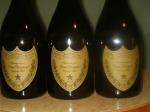 Reader Bob Brown (shame, shame, he failed to provide his email location) poses an interesting question about three currently available vintages of the tetes de cuvee Champagne, Dom Perignon.
Reader Bob Brown (shame, shame, he failed to provide his email location) poses an interesting question about three currently available vintages of the tetes de cuvee Champagne, Dom Perignon.
Brown writes: “I have been offered 1995, 1996 and 1998 Dom Perignon vintages for about the same price per bottle. Which vintage would you recommend?”
This one’s a slam-dunk. The 1996 Dom Perignon is one of the greatest ever made, and is certainly chef de cave Richard Geoffroy’s crowning achivement in a brilliant career at Moet. The 1995 vintage was exceptional as well, but the depth and power of the ’96 Dom are clearly superior to both the ’95 and ’98.
It should be noted that Dom retails for approximately $120-$140 depending upon your location, though in my neck of the woods (southern California) it can be found for considerably less around the holidays, particularly at Costco.
This comparison does serve to point out the inadequacy of the “line pricing” that is used almost universally in today’s wine trade. At one time a wine’s price was a reflection of the vintage and the estimation by the producer of the quality in the bottle.
That pricing model was abandoned sometime in the 1980s. Now wines are priced by stature, regardless of vintage. Enthusiasm for a vintage will often drive prices higher after they’ve been released, but the price almost never goes down from one year to the next on classified-growth Bordeaux, A-list California Cabernets or premier and grand cru Burgundies.
‘Tis a shame. Some of my shrewdest wine purchases were Bordeaux from so-called “off vintages” in the 1970s and early 1980s.
8
